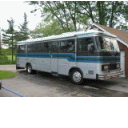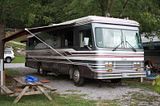Page 1 2
Go to...  | Start A New Topic  | Search  | Notify  | Tools  | Reply To This Topic  |  |
 |
Thought I would see what people know about the propane tank on their coach. The spec sheet says ours is a 165 lb. tank, which, I think, would mean it has a nominal capacity of about 40 gal. When I had it filled this morning it appeared to leak (drip) lpg. The young guy making the delivery to our site had added 13.5 gal of lpg. He thought something was wrong and I think that too. ... Maybe... There is no indication of leaking propane at any other time except when he was filling it. These large tanks don't have an opd like the one on your 20 lb. grill tank. Maybe it's just indicating a full tank by venting when it is full? But, I don't remember seeing it blow off excess lp when we have had it filled before. Now, I haven't filled the tank in the fog & pouring rain before either! Anyways, we are off propane until we have the tank inspected and repaired as needed. We are booked into Al's RV on Bell Road here in Phoenix next Tuesday since they are who the propane service recommends. The tank is nearly 20 years old and that's the only way I'll feel safe. Your comments are appreciated. Don 1990 Regency 34' Cummins 6CTA 8.3 240hp Spartan Chassis, 4 speed Allison MT643 | ||
|
I have a 40+ gal propane tank in the Breakaway and when they fill it, there is a blow off valve that they open, as soon as it blows propane they shut it off, it will smell of propane for awhile after filling. I can only fill my tank to about 80% full as that is where the blow off occurs and I think that is how it is designed. Ed 94 30' Breakaway #3864 30-BS-6B side entry New Cummins 5.9L, 375+ HP Allison 6 speed Spartan chassis K9DVC Tankless water heater | ||||
|
 2/10 2/10 |
Having a "drip" is interesting---- propane as a liquid product (at atmospheric pressure and Phoenix temperatures)should have a half life of a second or so before being a gas. Our tank on the 1977 has a blow off valve, and so too does the 93 Breakaway Bud 1993 Breakaway 36ft & 1977 20 ft Spartan: air ride and brakes & P32(?) Cummins: 8.3 litre 250hp, PACBrake Allison 3060 (6 spd) Front entry, side hallway 7.5 kw diesel gen. 1999 2dr Tracker 4X4 5spd, SMI Braking system | |||
|
| The Old Man and No Barth |
MWrench is right. If your tank stops venting propane after it's filled, it's behaving normally. It's not uncommon for attendants to be slow in shutting off the flow when the overfill protection valve starts to vent. Also, sometimes they don't achieve a leak-proof connection when they start filling, & the equipment tends to be old & abused. If the connection isn't perfect, liquid propane will drip. Furthermore, "the young guy making the delivery," probably had 2 minutes of instruction, & has never been properly impressed with the need for safety in handling propane. A thing for you to remember is to shut off all pilot lights when filling either propane or gasoline. The kind of liquid leak you had creates an unpleasant KABOOM when the fumes reach an ignition source. Check the "Re: Quartzsite," thread for my experience with the filler valve on my Barth. | |||
|
| First Month Member |
Mine (and previous) has a spit valve that is opened before filling, and vents vapor as the tank is filled. It spits liquid/vapor when the tank is 80% full. At that point, it is closed and filling should be terminated. It also has an over pressure valve that releases when the pressure is too high. If the tank is filled without the spit valve open, the over pressure valve will release when things warm up a little. Being right behind the driver, this can be startling. Sometimes, a propane tank will have a little oil in it, and will drip wherever there is some leaking or venting, or even at a disconnection point. I find a little oil on the connections when I disconnect my BBQ hose. . 84 30T PeeThirty-Something, 502 powered | |||
|
 3/11 3/11 |
Something as critical as your propane tanks should not be "mini-maintained". On my several coaches I removed the tank and all the fittings and then took it to be sand blasted by an industrial tank cleaning company. Once they were through I had it powder coated, inside and out. I ran a thread chaser on all the fitting holes and replaced all the fittings with new ones (available at RV or online stores) and then replaced all the flexible hoses. Only after all that did I feel comfortable in dragging a time bomb around the country under the floor of my coach. And I don't have to contend with snow, ice and road salt. All this was considerably less than buying a new 40 gallon tank and then paying for replacement of the gauges, valves and shutoff. 1993 32' Regency Wide Body, 4 speed Allison Trans, Front Entry door, Diamond Plate aluminum roof & 1981 Euro 22' w Chevy 350 engine and TH 400 tranny | |||
|
 8/10 8/10 |
Hey Don... We just had this discussion recently, as I had the same thing happen to me this summer. Went to the fuel station in town where I typically fill propane and as soon as the guy started to fill my tank, I noticed dripping and vapor coming from the braided "tank-fill" hose, which leads from the fill inlet on the side of the coach to the fill valve on the tank. He shut it down after only filling about 3 gallons and the "leaking" stopped immediately. I went to a local propane conversion shop and the guy made me a new fill hose utilizing the "ends" from the original hose and only charged-me about 25 bucks. I was back in business in about an hour and went down and had the tank filled without any leaking from the fill line. Our coaches are the same age, so maybe EVERYONE should take a look at this chunk of braided hose, as it was really obvious where the leak was coming-from. My hose actually had a metal connector [splice] in it from possibly a previous leak installed before my time. The guy at the shop asked-me [jokingly] if I wanted the splice installed in the same place ...I told him I would pass on that offer. About 40 gallons is corrct based on my past filling experience... ~Mac~ 1990 31 Foot Regency Spartan Chassis Cummins 6CTA8.3 Alison MT643, 4-speed 8905-0123-31RDS-A2 | |||
|
 8/10 8/10 |
SEARCH under LP Gas Leak for more information on this topic. You also might want to check-out *RV FIRES* on youtube to get an idea of how those things work in a venting situation while the hose jockeys are attempting to get "the wet stuff on the red stuff"... ~Mac~ 1990 31 Foot Regency Spartan Chassis Cummins 6CTA8.3 Alison MT643, 4-speed 8905-0123-31RDS-A2 | |||
|
"Host" of Barthmobile.com 1/19 1/19 |
I seem to remember more than one member recently having this same problem with the propane fill hose. I think this should be on "Everyone's To Do List" now that a pattern has emerged. Also, check the "Flex Hose" at the generator.
| |||||||||||||||
| ||||||||||||||||
 9/12 9/12 |
We had a drip in 2007 about midway along the braided hose which carries liquid propane to the generator in the front. The ACE hardware store in Hagerstown, MD (about 10 miles away from where we stopped in PA for the night @ Keystone RV) just happened to be the regional propane specialist. Keystone got 30' of hose from ACE and replaced it, using our old fittings. No drip. Had I read MWrench's post about replacing the braided hose with steel I would have done that. Before we leave Phoenix I am going to remove & replace all the fittings, do a tune up on the generator and paint the bottom of the tank while I have everything apart. Carl Feren 30'- 1992 Breakaway on Spartan Chassis 5.9L Cummins 190 Banks Powerpack Allison 4 spd - 542B 9206-3805-30BS-6B 7KW Kohler Propane Genset | |||
|
| First Month Member |
Check to be sure any hose in a propane system is UL listed for propane. Some places are loose on that. The wrong rubber compound could interact with the propane and produce cloggy stuff or degrade the rubber or develop a leak or whatever. A perforated outer jacket is also part of the deal, to prevent gas build-up among the various layers of the hose.. My hose man will not use screw-in type reusable couplings, preferring crimp only. . 84 30T PeeThirty-Something, 502 powered | |||
|
| The Old Man and No Barth |
Medic 37 reports a "braided "tank-fill" hose which leads from the fill inlet on the side of the coach to the fill valve on the tank." I have only seen direct connections between the fuel station hose & the tank. I would view any flexible filler arrangement as a design flaw. In a normal propane system, the only pressure downstream from the regulator mounted on the tank, is "11 inches water column," which is less than 1/3 psi (according to answers.com, 27.71 inches water column equals 1 psi). On the other hand, propane requires 177 psi to keep it liquid @ 100 degrees F; proportionately less in lower temperatures, proportionately more in higher temperatures. That's why propane tanks are built so strong. Any flexible hose between the fill inlet & the on-board tank would have to withstand higher pressures than that to have a safety factor. In my view such a connection constitutes an unnecessary hazard. I have owned 3 class A, & 3 Class B motor homes, all of which had horizontal propane tanks installed in a way that allows direct connection of the fill hose to the tank. The 4 travel trailers I have owned, had removable vertical propane tanks mounted outside the trailer box, connected to the regulator by pigtails. All but one of those were were flexible hose. The exception had pigtails of solid copper tube. There are literally thousands of RV fires every year, most of which are caused by something other than propane. Where propane is a cause, it is almost always failure in an appliance, or somewhere in the internal plumbing. Storage tanks are rugged items. They indeed can be time bombs, but not until the coach is already on fire from some other cause. | |||
|
That is a new one one me too! have never seen a tank that was not directly hooked up to the nozzle when filling. Seems to me that somebody once told me that propane is under 3 or 4 thousand psi when it is being pumped into your tank. Anybody able to confirm this or not? Was told that is why you need to make sure that the valves on all of your lines are shut off so that your appliances are not damaged. I always do this myself because sometimes you get somebody young who does not know about it or forgets it. I have a friend in Yuma that works for a propane company. The next time i see him i will ask him about this. He might be the one that told me this in the first place. | ||||
|
The tanks can be bombs. While we lived on Maui in the late 80's and 90's a guy and a 16 year old kid were killed filling a portable tank. They think that one of them hit it, (the valve maybe? might of been leaking) with a crescent wrench. Found pieces of the tank 1/3 of a mile away. | ||||
|
| The Old Man and No Barth |
My impression of my replacement propane fill valve is that it was a diaphragm-type check valve that closed & sealed from internal tank pressure. If that is true, filling the tank would require only enough pumping pressure to overcome the internal tank pressure, which would be 117 psi, more or less, depending on the temperature of the gas in the tank. The propane is pumped in liquid form so the supply tank must have a positive displacement pump capable of much higher pressures, though it only requires enough to overcome the internal pressure in the tank being filled. | |||
|
| Powered by Social Strata | Page 1 2 |
| Please Wait. Your request is being processed... |
|
This website is dedicated to the Barth Custom Coach, their owners and those who admire this American made, quality crafted, motor coach.
We are committed to the history, preservation and restoration of the Barth Custom Coach.
We are committed to the history, preservation and restoration of the Barth Custom Coach.



